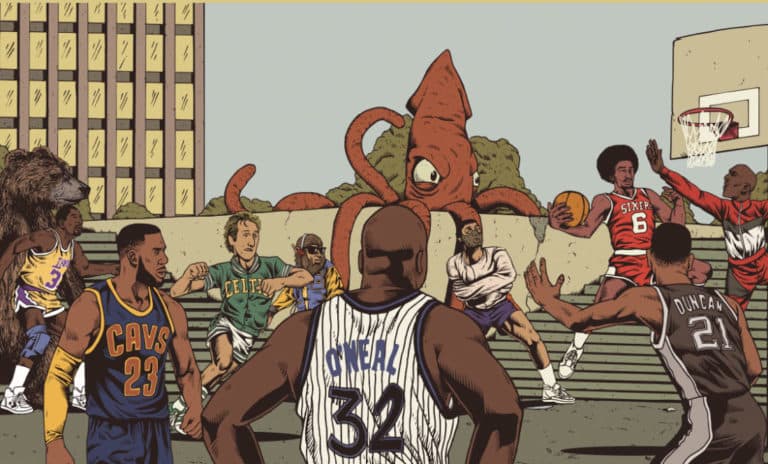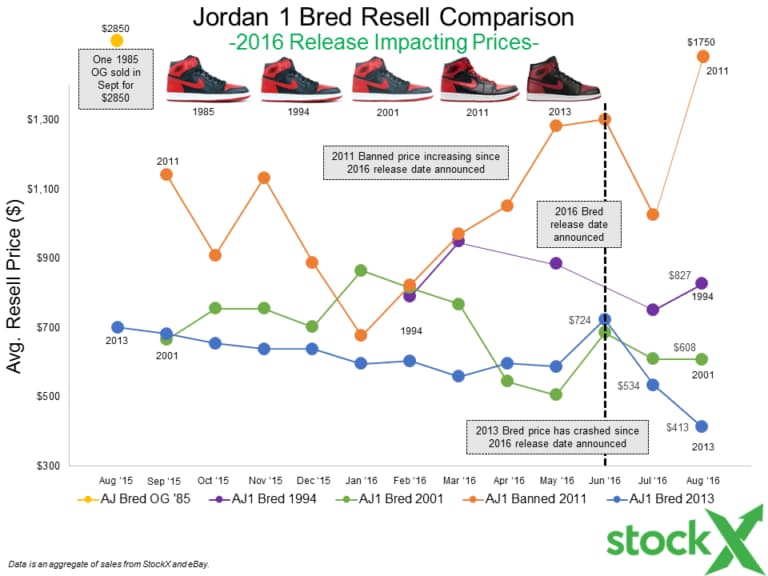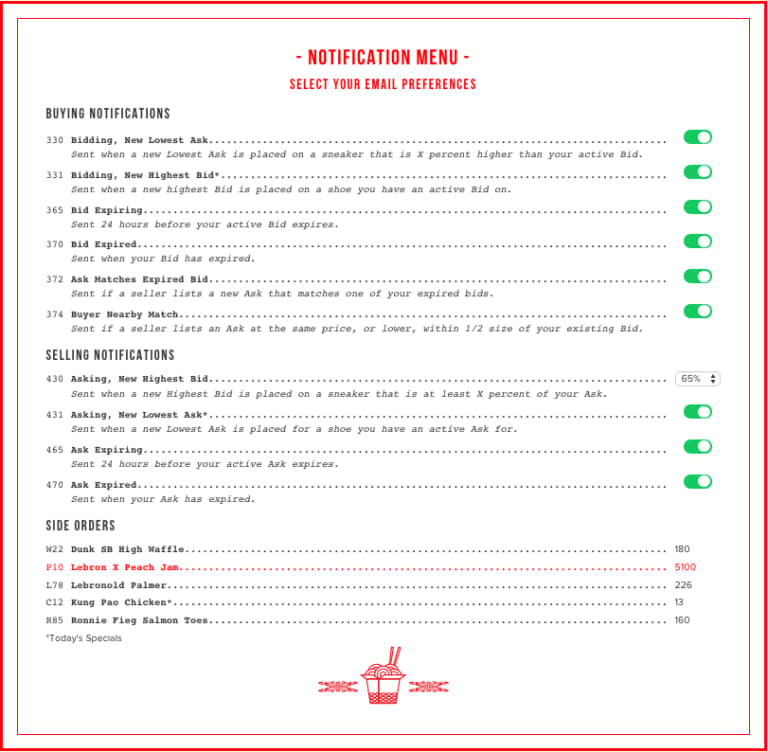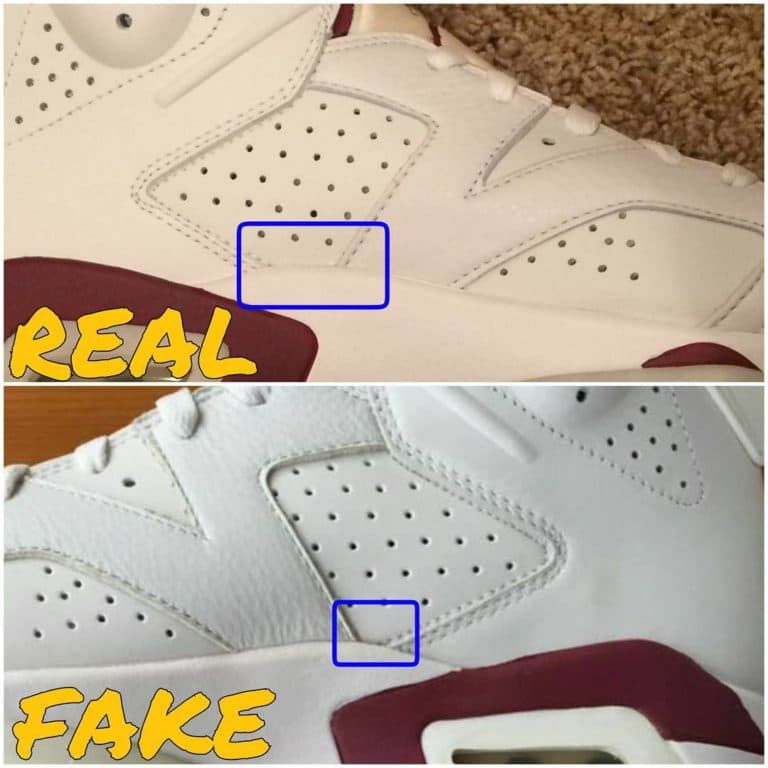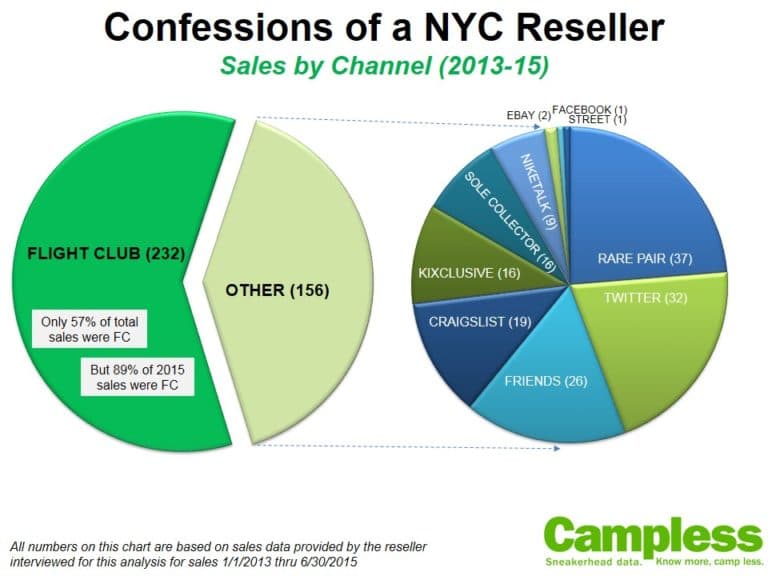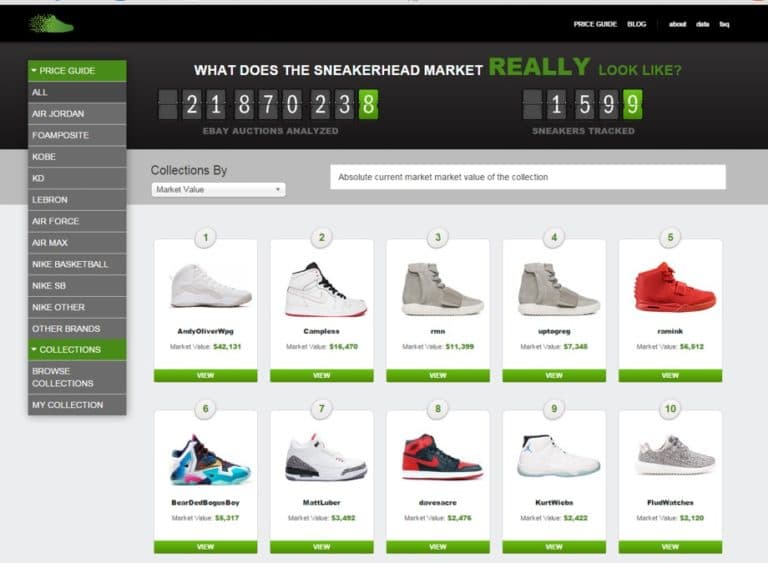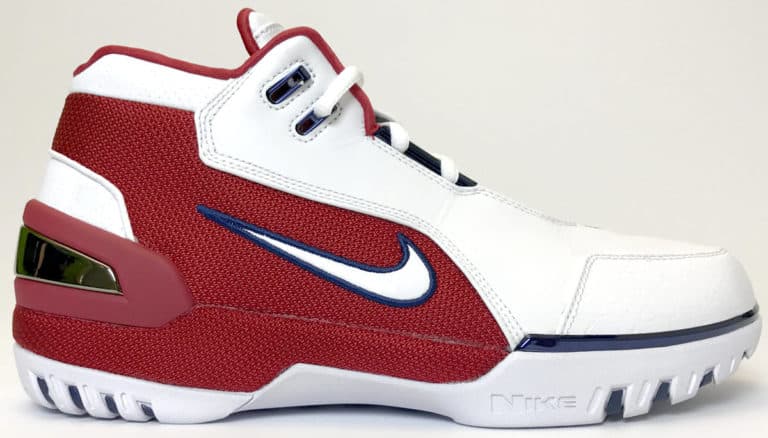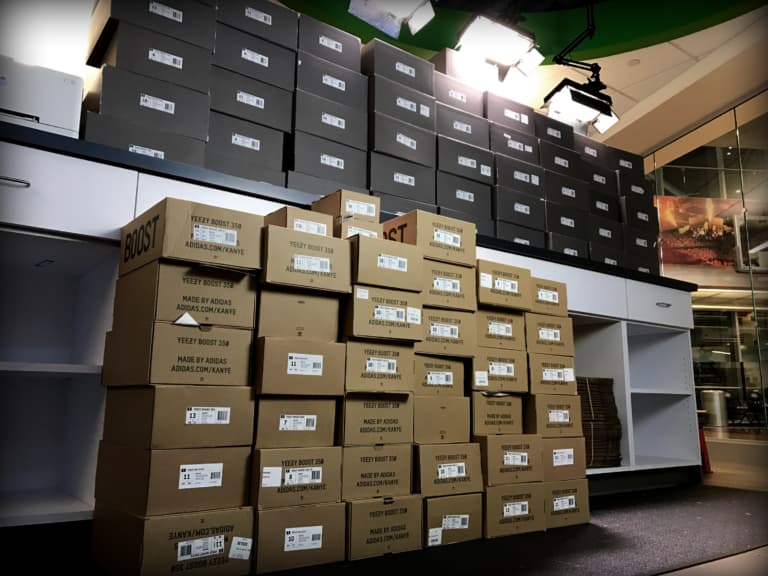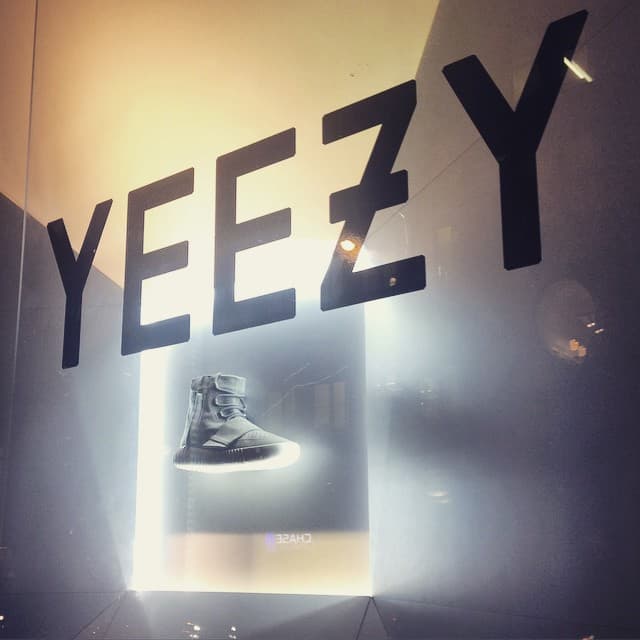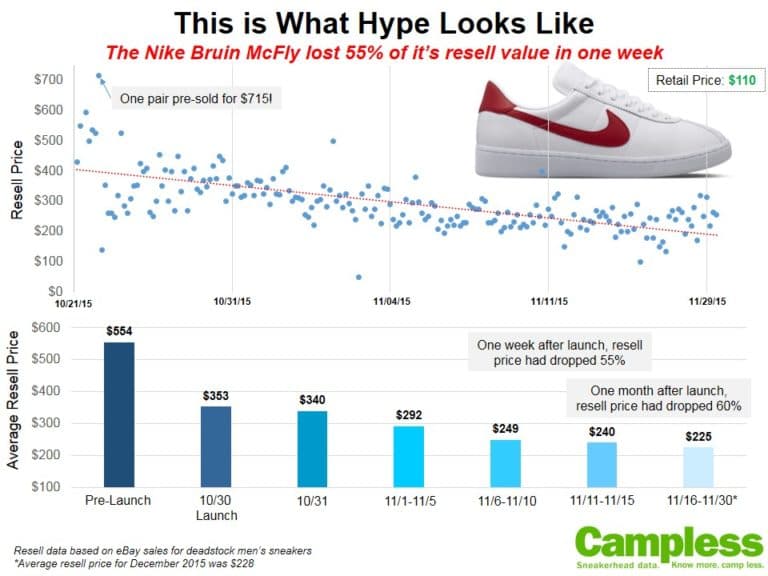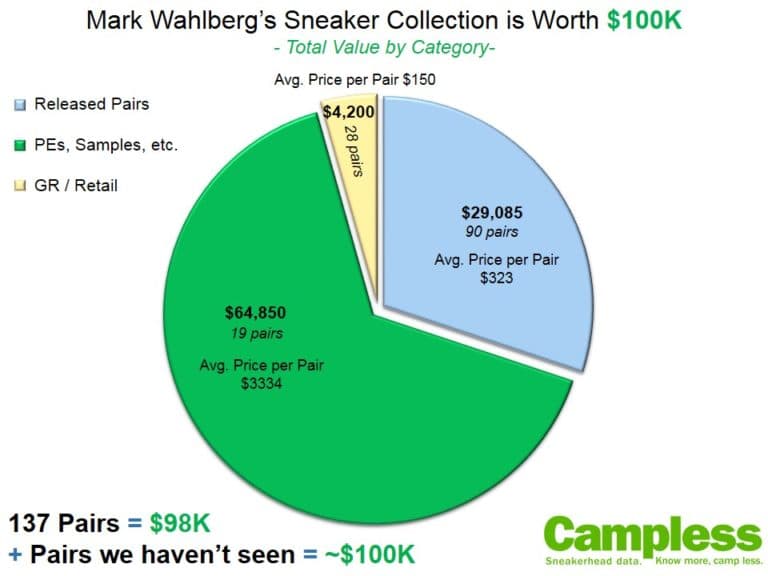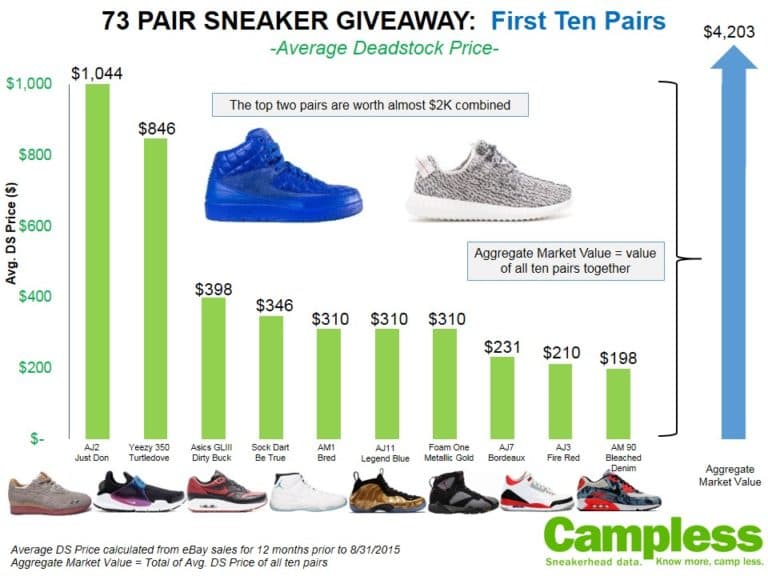In Part 1 we teed up the issue: Yeezy 2 auctions are filled with fakes. We explained what data outliers are, and why we need to remove them. Now let’s explain how.
Below is a histogram showing the price distribution for our focus data set – Yeezy 2 eBay sales, combined Solars and Plats, deadstock only:
A histogram is a graph which create “buckets” for a range of values, and then displays how many data points fall into each range. In this case, we’ve created one bucket for 16 different price ranges. The first bucket is $0-$100. The second bucket is $101-$250, and so on.
The blue bars show the number of pairs sold for a price which falls into that particular price range (bucket). For example, 167 DS pairs sold for between $0-$100. And that alone should start raising some questions. The Yeezys RETAILED for $250 – how the hell can they resell for fifty bucks?!?! The answer is: they can’t.
How does Campless eliminate fakes from data?
As a general rule we ignore any sales less than $100 – it’s usually a junk auction, like a semi-private listing where the actual transaction happens offline. For all DS sneaker analyses on Campless we set a minimum threshold, usually $100. If it’s less, we automatically ignore the data point. Sometimes that minimum is more, sometimes less, depending on the retail price and average resale price of the sneaker. For some pairs, particularly those which are part of packs, we also use maximums.
For most sneakers, after the minimum and maximum are set (which is done at an individual, sneaker by sneaker basis), we then systematically and automatically apply a 2-times standard deviation cutoff to eliminate outliers. What this means, statistically, is that using that cutoff eliminates many auctions that are very likely to be fakes. Using a standard deviation cutoff is a very common statistical method to eliminate outliers.
How do we identify fake Yeezys from the data?
For most sneakers, this is the end of our outlier analysis – minimum, maximum, and standard deviation cutoff. But with Yeezys and other sneakers with a high percentage of fakes (usually ultra-limited hyperstrikes), we take a closer look and examine the data one sneaker at a time. We take what we know about that particular sneaker to create additional hypotheses to test, which lead to rules to eliminate outliers, and allow us to arrive at the purest data set possible.
Put simply, Campless takes extra steps to make sure our sneakerhead data is accurate.
The first step, then, is to ask: What do we know about the fake market, in general?
Most “Disguised Fakes” sell for just slightly less than authentic sneakers
When people try to pass off variants as legit – i.e., “Disguised Fakes” – the price is usually slightly less than an authentic pair. For example, if most DS Jordan Retro 3 Black Cements are selling for $250-300, and someone lists a pair for $125 screaming “100% AUTHENTIC!”, I think we can spot the issue. But if that same dude lists his for $240, well, that hits at the center of our industry’s most significant problem.
What do we know about the Yeezy 2 fake market?
Yeezy 2 has an “Open Variant” market
It’s critical to know that unlike most fakes (or variants, AAA, etc.), there is an “Open Variant” market for Yeezys. This means that people are openly admitting they are selling a fake – they are not trying to pass it off as authentic. While there are plenty of Disguised Fakes, as well, there are also many auctions like this one:
- Title: Nike Air Yeezy 2 NRG Deadstock Carved Scales AAA 8 Kanye West
- Description: Nike Air Yeezy 2 Size: 8 US MENS Condition: Brand new in box Comes with: Everything: Box, laces, bag, etc. These shoes are extremely high quality! The shoes’ soles light up and the scales are carved
- Price: $239.99
Note, in the Title it says “AAA” and in the Description it says “extremely high quality.” This seller is not hiding the fact that these are variants. And for $239.99, it would be comical to think otherwise.
Open Variants sell for significantly less than authentic sneakers
While Disguised Fakes are often priced just slightly less than legit pairs, Open Variants are usually priced significantly lower (see, e.g., the $239.99 pair above). This is necessary – Open Variants have to be priced low in order to induce a purchase. They’re selling to an entirely different market – people who knowingly buy fakes. Say what you want about these folks – call ’em out, chop ’em down, post their pics to Fake Files – but the fact remains that the market exists.
There should be two clusters of Yeezy 2 sales – one centered around fakes, the other centered around authentic pairs
The existence of an Open Variant market for Yeezys, and our knowledge about the pricing structure for Open Variants vs. Disguised Fakes, helps us predict what the Yeezy 2 data should look like. Specifically, we should expect to see two significant clusters of sales – one centered around the average price of Open Variants, and one centered around the average price of the real deal.
So let’s look at the histogram again:
Sure enough there are two clusters of sales – one centered around the $250-500 bucket, and one centered around the $1500-$1750 bucket. Logically, this makes sense: $1625 for a real pair? $375 for a AAA variant? Sounds right. For a more validated check, we can go to Flight Club historical pricing – where sales are definitely authentic – and see that the average price of the Platinum Yeezy 2 since its release has been $2,489. Take away the 20% consignment markup and average price is right around $2,000. That leaves another 20% premium to guarantee authenticity, and we’re exactly in our eBay range.
Where do the fakes end and legit pairs begin?
The key question, then, is where is the cutoff? Where does the cluster of Open Variants end and the cluster of real pairs begin? Somewhere in-between are the Disguised Fakes. We need to figure out where that line is.
We’ll pick up there in Part 3 . . .




